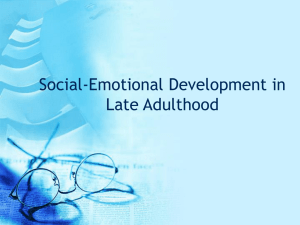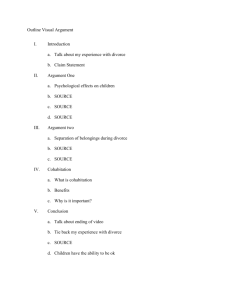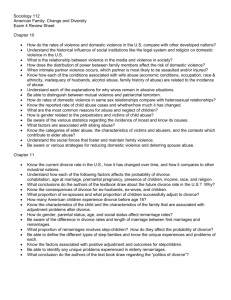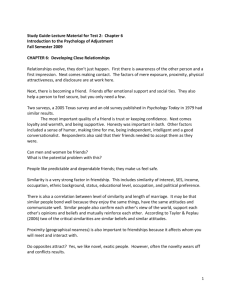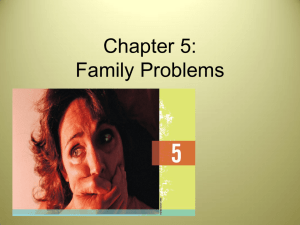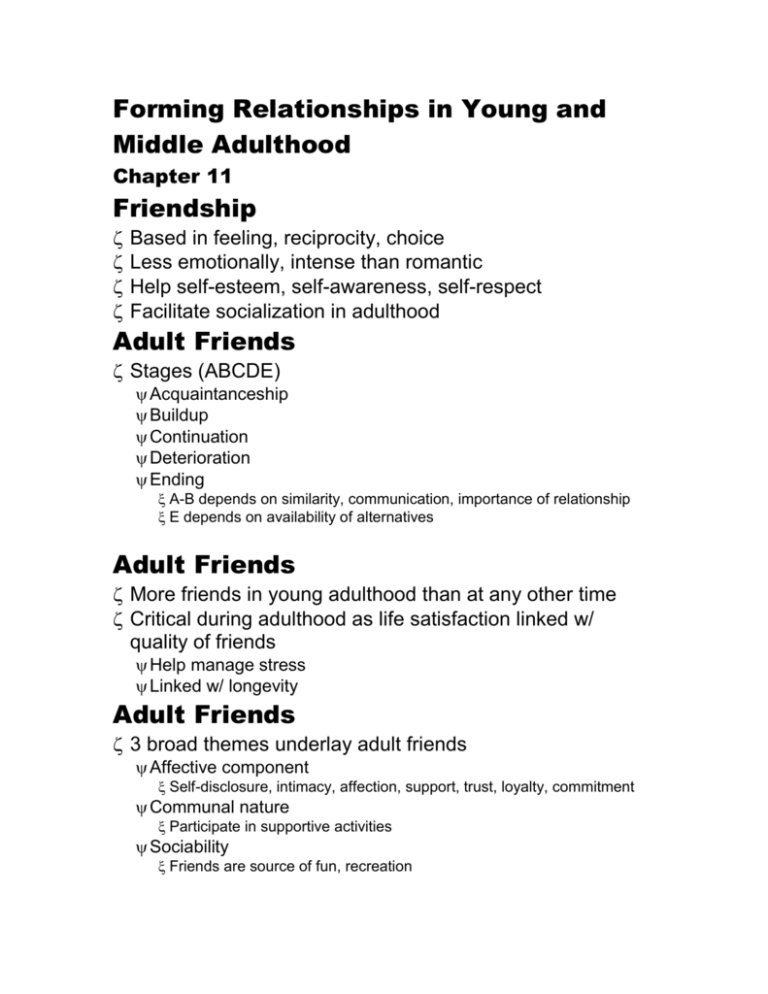
Forming Relationships in Young and
Middle Adulthood
Chapter 11
Friendship
Based in feeling, reciprocity, choice
Less emotionally, intense than romantic
Help self-esteem, self-awareness, self-respect
Facilitate socialization in adulthood
Adult Friends
Stages (ABCDE)
Acquaintanceship
Buildup
Continuation
Deterioration
Ending
A-B depends on similarity, communication, importance of relationship
E depends on availability of alternatives
Adult Friends
More friends in young adulthood than at any other time
Critical during adulthood as life satisfaction linked w/
quality of friends
Help manage stress
Linked w/ longevity
Adult Friends
3 broad themes underlay adult friends
Affective component
Self-disclosure, intimacy, affection, support, trust, loyalty, commitment
Communal nature
Participate in supportive activities
Sociability
Friends are source of fun, recreation
Siblings As Friends
Important relationship for most
Peaks during adolescence & late life
At all times women place more importance
Gender Differences: Friends
Women
Friendships based on intimacy, emotional sharing, disclosure of
personal matters
More relationships than men
Men
Friendships based on shared activities or interests (e.g, sports)
& competition
Less intimacy & disclosure
Love
Sternberg
Passion
Intimacy
Commitment
In a lasting love relationship
Passion high early I & C low (but I rising fast)
Passion fades, I stabilizes & C rises
Falling In Love
Assortative Mating
Similarity predictions attraction
Only to a point
Only for key, important dimensions
• Religion, sex, politics, physical appearance
Falling In Love
Compatibility leads to application of 3 filters (Murstein)
Stimulus
Appearance, social class, manners match?
Values
Values match?
Role
Ideas about relationship, communication style gender roles match
All YES = couple formation
Abusive Relationships
Continuum of aggression
Verbal - physical - severe - murder
Less severe common
25%-40% of relationships display less severe physical abuse (punching,
slapping) occasionally
Severe less common
Usually long pattern of abuse of male partner
Abusive Relationships
Cause of abuse depends on type of abuse
Verbal: need to control, jealousy, misuse of power (all also impact
more severe forms of abuse)
Physical: abused as child, alcohol, positive attitudes towards
violence, aggressive temperament (all also impact more severe forms of
abuse)
Severe/murder: personality disorder, emotional instability, poor
self-esteem
Abusive Relationships
Cause also depends on gender
Need for control, power, jealousy M > W
Culture key as well
Cultures valuing female honor, passivity, nurturing, loyal
supporters of higher-status males more accepting of abuse
Lifestyle
Singlehood
~80% men 20-24 single
~70% women 20-24 single
Some career focused early in adulthood
More difficult for single women than men
Social pressure stronger on women to marry
Men marry later
2x as many African Americans single in young adulthood
Singlehood
Never married women in 30s
Acute distress & wish to be married OR
Emotionally volatile OR
Happy single
When does one decide to be single?
Gradual process for most
Singlehood
Advantages & disadvantages
Greater freedom
More lonely
Men: higher mortality, alcoholism, suicide rates
Women: more vulnerable to violent crime & extra duties at work
Cohabitation
Dramatic increase in past 30 years
Most are 25-44 (v. > 45 in 1970s)
3 primary reasons for cohabitation
Limited: convenience ($, sexual access, no commitment)
Premarital: trial marriage
Substitute marriage: long-term commitment w/o marriage
Cohabitation
Cultural differences abound
Sweden: 99% of couples live together before marriage & 25%
unmarried
China: cohabitation rare
Impacts on marital success
Reduces marital satisfaction
Increases risk of divorce
Gay & Lesbian Couples
In most ways they are similar to heterosexual couples
Some differences do emerge
Less likely to argue about
Values, social-political issues
More likely to argue about
Trust, former lovers
Gay & Lesbian Couples
Gender differences more key
Men: separate sex & love, have more short term relationships
Women: connect sex w/ love, have fewer, longer lasting
relationships
Gay couples report less family support
Legal system fails to recognize rights of gay partners
Marriage
Median age increased in past 30 years
Younger you marry higher risk of divorce
< 20 3x higher rate than 20s & 6x higher rate than 30s
Factors predicting marital success
Identity
Homogamy (similarity)
Perceived equality (fair exchange)
Marital Happiness
Peaks & valleys
Generally happiest early & late
Drops during children
Rises after children leave home
Best if dependence is equal for both partners
Keeping a Marriage Happy?
Make time
Express love
Be there in times of need
Constructive communication
Show interest
Confide
Forgive, understand
Family Life Cycle
Having children bring benefits & problems
Personal satisfaction/needs, etc
Financial, personal sacrifices
Decision to have kids impacted by Fs
Having Children?
Feminine intrapsychic determinants
Relationship w/ parents, flexibility, feminine identification
Marriage determinants
Stability, support satisfaction, stress management
Having Children?
Career determinants
Responsibility, satisfaction, change possible
Lifestyle determinants
$, child-free relationship, comparison group
Parental Role
Currently couples have fewer kids later
Older mothers more affectionate, sensitive
Older fathers more invested, spends more time w/ child
Being a parent very stressful
New responsibilities
Changes relationship (ALL about child)
Worse for mother (especially is she works)
Men spend ~44% of the time raising kids v. moms
Single Parents
Mostly women due to
Divorce
Keeping child out of wedlock
Ethnic differences: 70% AA births out of wedlock
Impacts on parents
Emotional difficulty
Financial problems (worse for single mothers)
Dating difficult (lonely)
Alternative Parenting
Gay couples raising children
No negative impacts
Some potential positives
Divorce
Divorce rate - 50% in US
Highest in Russia, lowest in Netherlands
Increased in developed countries recently
Changes in social norms, laws
Reasons cited by men & women for D
Unhappy, infidelity, sexual problems
Men: alcohol abuse by self, women’s lib
Women: alcohol abuse by spouse, physical abuse
Divorce
Factors impacting divorce
Macro reasons
Social-cultural changes/values, gender roles
Demographics reasons
Age at marriage, parental divorce, cohabitation
Interpersonal reasons
Infidelity, violence, $, children, growing apart
Divorce
Impacts of divorce on couple
Emotional problems (lasting)
Depressed, rejected, angry, disappointed, unhappy
Divorce hangover
Unable to let go and move on as single person
Preoccupation predictor of poor adjustment
• Men: accept blame, move out, social life changed
• Women: fewer remarriage, friends prospects, $ troubles
Divorce
Relationship w/ children
70% mothers regain custody after divorce
Fathers become negligent rapidly
Problems extend to divorce w/ adult children
Emotional difficulties & poor father relationship
Remarriage
Very common (W < M)
Average wait is 4 years
Increased change of divorce (even more w./. stepchildren)
Women benefit more than men



